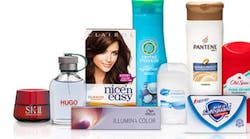Procter & Gamble Co.’s (IW 1000/50) drive to sell more upscale skin-care, grooming and house-cleaning products is beginning to show up in its bottom line.
Sales of its premium brands helped lift earnings to $1.08 a share last quarter, excluding some items. Analysts estimated $1.06, on average.
The results reflect a crusade by CEO David Taylor to get consumers to pay a bit more for the items in their bathroom cabinets and kitchen pantries. P&G’s premium SK-II skin-care brand helped sales in the beauty division last quarter, and scent beads and Tide pods for high-efficiency washers boosted the home-care unit, giving the company a leg up on sellers of bargain health and cleaning products.
While total revenue slipped 0.3% to $16.9 billion, that topped analysts’ $16.8 billion average estimate. Organic sales -- which exclude the effects of acquisitions, divestitures and currency exchange-rate fluctuations -- rose 2%, Cincinnati-based P&G said.
Sales by that measure rose 3% in the beauty division. Organic sales gained 7% in health care, driven by innovation in oral-care products. Organic sales increased 1% in the grooming, fabric & home care and baby, feminine & family care units.
Profit Forecast
The company reiterated its forecast that earnings per share, excluding some items, will gain at a mid-single-digit percentage this year. Organic sales may increase as much as 3%, up from a previous projection of 2%.
Taylor, who took over as PG’s CEO in November 2015 after 35 years with the company, pledged to make the owner of Tide, Pampers and Olay a more nimble and innovative competitor. Once known for churning out hit products like Swiffer mops, P&G has struggled to invent new blockbusters in recent years.
P&G’s challenges aren’t unique. New brands, particularly those with natural or organic ingredients, have attracted younger shoppers, a trend that prompted Unilever’s acquisition of Seventh Generation Inc. last year. Large consumer companies also are coping with higher ingredient costs, sluggish demand and a stronger U.S. dollar, Goldman Sachs Group Inc. analyst Jason English said in a report downgrading the household products sector to cautious. English also lowered P&G to a sell rating this month.
By Lauren Coleman-Lochner



